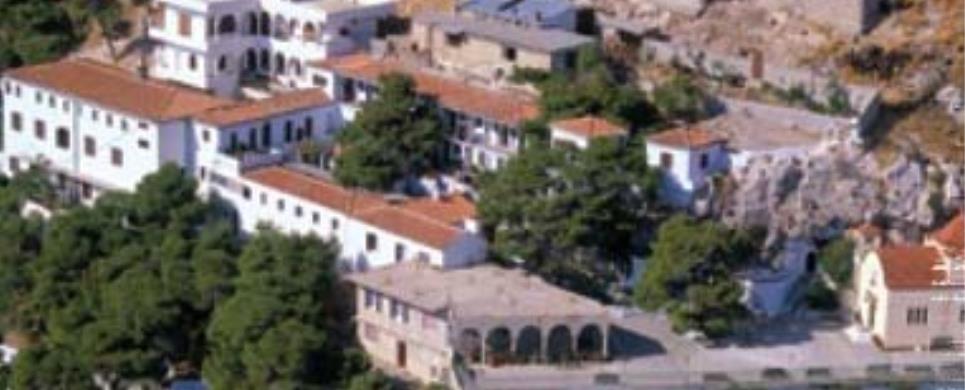Listed 4 sub titles with search on: Main pages for wider area of: "LOUTRAKI Town CORINTHIA" .
LIMNI VOYLIAGMENIS LOUTRAKI (Lagoon) LOUTRAKI-PERACHORA
The peaceful lagoon of Vouliagmeni lies 16-km. northwest of Loutraki
and was caused by the subsidence of the ground to α kind of trench.
The lagoon is 2 km. long and up to 1 km. wide. Its depth is estimated
at 40 m. Α channel of 6-m. width provides an outlet to the sea.
In ancient times, it was called Eschatiotis (meaning the “last” part
of the promontory) or Corgopis (from the mother of Megareus, who was drowned in
its waters). No trace has survived of the ancient Megarean colony of Aegeirus,
which stood to the north of the lagoon.
A settlement dating back to the early Helladic I period was discovered
by the archaeologist J.M. Fossey about 30 m. west of the channel from the lagoon
into the Gulf of Corinth.
Another settlement, of early Helladic 11, has come to light to the
north-west, and 300 meters from this an ossuary of the same period yielded the
bones of 10 dead and some 500 vessels. It can be concluded from the scattered
finds of sherds that in the third and second millennia BC, families of farmers
and fishermen sparsely inhabited the area.


LOUTRAKI (Town) CORINTHIA
Where the past and the future spin their web, the present reveals
a secret paradise, ideal for as many of the year's 365 days that a visitor chooses!
The unique combination of climatic conditions and exquisite natural environment
make Loutraki an ideal location with limitless possibilities for both winter and
summer tourism. Its mild Mediterranean climate, the crystal clear sea and its
beautiful beaches, which have been awarded the “European Blue Flag”
continuously sine 1987, as well as the thick fir-tree of the Gerania
mountain range that spreads around it, all composes a picture of incomparable
beauty!
The prolonged sunshine that prevails in the area all year round, the
absence of humidity, the fascinating natural environment that is created by the
combination of mountain and sea, and its famous medicinal and natural mineral
waters are the most important factors that contribute to the development of recreational
and therapeutic tourism! The ideal place for holidays, whatever your preference
may be: swimming and water sports at the very clean beaches, mountain sports,
hiking, monuments and sightseeing within a very short distance, easy access to
the most important achaeological sites in Greece,
rich cultural events and local festivals, lively night-life, impeccable organization
and service, friendly hospitable local residents, cosmopolitan atmosphere, excellent
tourist infrastructure, good road network for excursions to the nearby archaeological
sites. All these elements compose the picture of a dreamlike holiday resort, which
is gaining more and more fanatic friends.
(Text: Vana Nikolopoulou, Antonis Koukoulas)
This text is cited November 2003 from the Loutraki Perachora Municipality Tourism Development Enterprise pamphlet.

MONI OSSIOU PATAPIOU (Monastery) LOUTRAKI-PERACHORA
Tel: +30 27440 22496
At a distance of 14 km from Loutraki,
along the road to Perachora,
on an imposing site and at an altitude of some 700 m., on a spur of the Geraneia
mountains and above the calm waters of the Gulf
of Corinth, stands the nunnery of Hosios Patapios. The interior of the nunnery
is reached by a spiral flight of 144 steps; amid the pine-trees on the right,
stands the chapel of the Hosia Mary of Egypt.
PERAEON (Ancient area) LOUTRAKI-PERACHORA
“Peraeion” or “Peraea” was the name often given in antiquity
to stretches of coastline, which were across α body of water from an important
city. The Peraea of Corinth,
on the other side of the Gulf
of Corinth, included the whole land to the Northwest of the Isthmus,
where Loutraki and Perachora
stand these days. The area was first settled around 750 BC, by Corinthians, whose
occupation of the Peraea made them masters of the entire Gulf
of Corinth. In 392 BC, during the Corinthian War, Peraea was captured by Agesilaus
of Sparta. In 243 BC, Peraea
came into the hands of Aratus and the Achaean Federation, and enjoyed α period
of renewed prosperity. When the Romans devastated Corinth
in 146 BC, Peraea came under their control and was totally depopulated. The centre
of interest of the new conquerors shifted to Therma,
which was stood on the site occupied by Loutraki
now. It was not even in the late fourteenth century that Peraea came back into
the history books, and won an important position. Until recently, it was believed
that the Corinthian colony stood on the shores of the Vouliagmeni
lagoon, since many traces of housing and fortifications had come to light
there. This view is now questioned, and it seems more likely that the settlement
was further to the north, near the village of Asprokampos,
while the buildings at Vouliagmeni
have been interpreted as α camp or place of refuge near the sanctuary of Hera.

Receive our daily Newsletter with all the latest updates on the Greek Travel industry.
Subscribe now!